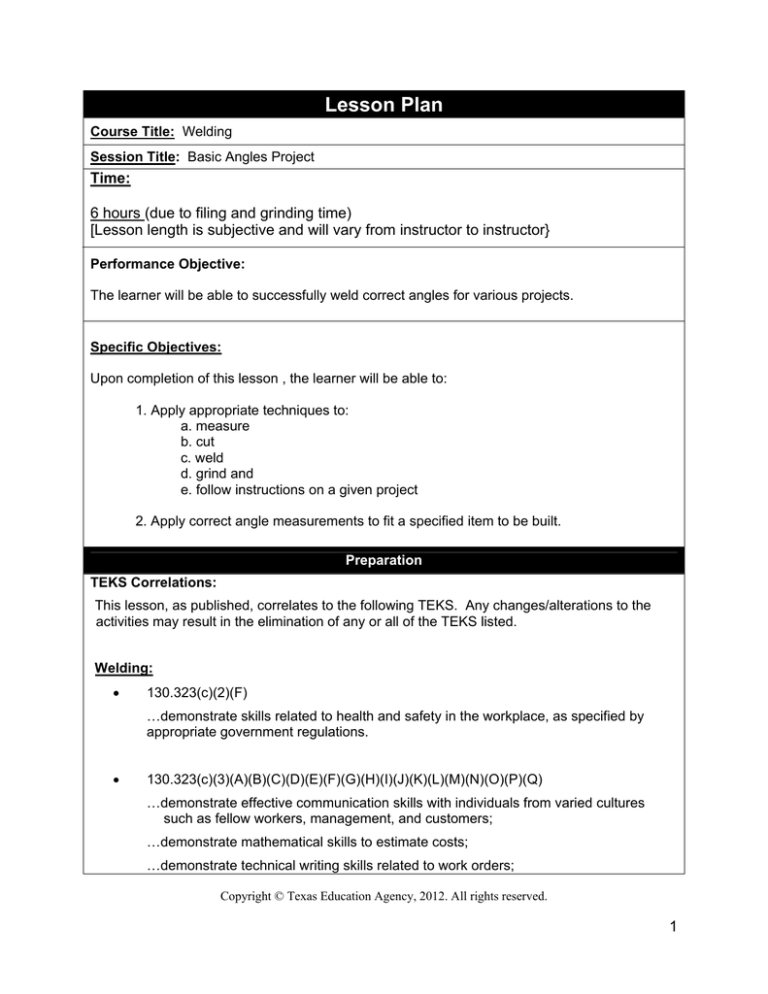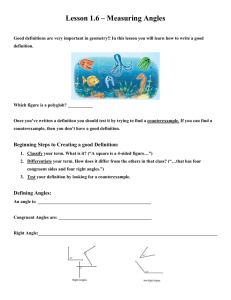Lesson Plan
advertisement

Lesson Plan Course Title: Welding Session Title: Basic Angles Project Time: 6 hours (due to filing and grinding time) [Lesson length is subjective and will vary from instructor to instructor} Performance Objective: The learner will be able to successfully weld correct angles for various projects. Specific Objectives: Upon completion of this lesson , the learner will be able to: 1. Apply appropriate techniques to: a. measure b. cut c. weld d. grind and e. follow instructions on a given project 2. Apply correct angle measurements to fit a specified item to be built. Preparation TEKS Correlations: This lesson, as published, correlates to the following TEKS. Any changes/alterations to the activities may result in the elimination of any or all of the TEKS listed. Welding: 130.323(c)(2)(F) …demonstrate skills related to health and safety in the workplace, as specified by appropriate government regulations. 130.323(c)(3)(A)(B)(C)(D)(E)(F)(G)(H)(I)(J)(K)(L)(M)(N)(O)(P)(Q) …demonstrate effective communication skills with individuals from varied cultures such as fellow workers, management, and customers; …demonstrate mathematical skills to estimate costs; …demonstrate technical writing skills related to work orders; Copyright © Texas Education Agency, 2012. All rights reserved. 1 …apply accurate readings of measuring devices, both U.S. customary and metric; …accurately use an appropriate tool to make measurements; …compute measurements such as area, surface area, volume, and perimeter; …determine how changes in dimension affect geometric figures; …calculate problems using whole numbers, fractions, mixed numbers, and decimals; …use a calculator to perform computations; …perform conversions between fractions and decimals; …understand the functions of angles; …apply right triangle relationships using the Pythagorean Theorem; …understand the parts of a circle; …identify the most reasonable mathematical solution using estimation; …use cross-sections of three-dimensional figures to relate to plane figures; …describe orthographic views of three-dimensional figures; and …describe isometric views of three-dimensional figures. 130.323(c)(5)(D)(E)(F) …analyze types of welding joints; …analyze positions of welding; and …identify types of welds such as fillet, groove, spot, plug, and flanged. Interdisciplinary Correlations: English: 110.42(6) – Reading/word identification/vocabulary development 110.42(6)(A) …expand vocabulary development through wide reading, listening, and discussing; Instructor/Trainer References: Instructor knowledge. Instructional Aids: 1. Basic Angles Project PowerPoint Presentation 2. Basic Angles Project PowerPoint Slides 3. Basic Angles Project PowerPoint Handouts Copyright © Texas Education Agency, 2012. All rights reserved. 2 4. Basic Angles Project PowerPoint Notes Materials Needed: ¼” plate for each student (pre-cut to specified sizes) Rods for each student (type of rod up to instructor) Equipment Needed: • • • • Welding set ups for each student to access Grinders for student access Files/brushes for student access Selection of t-squares, framing squares, combination squares, and protractor student access • Computer and projector for PowerPoint presentation Learner Basic safety skills. Introduction Introduction (LSI Quadrant I): Describe a scenario where a supervisor gives instructions needing an item built requiring a specific set of angles in the metal. SAY: “It is the worker’s job to fit the specs and make the item work appropriately. We’re going to make basic angles using pieces of pre-cut ¼” plate.” Outline Outline (LSI Quadrant II): Instructor Notes: Introduction. Give the students pre-cut 2”x 6” pieces of metal to use for the project. Show PowerPoint presentation Demonstrate: • Begin by reviewing the use and markings of the t-square, framing square, combination square, and protractor taught earlier in the semester during the measurement lesson). • Also review grinder safety. • Ask for questions and review if unclear. Break students into groups for practice sessions. Activities include: The build instruction handout should be given to students for their practice sessions. Copyright © Texas Education Agency, 2012. All rights reserved. 3 • Tack together pieces to create 90 degree angle. • Use the measurement tools to ensure angle accuracy. Cut in half to create a 45 degree angle. • Weld together on outside only (nothing on inside). • Grind and file to make clean lines, edges, and corners. Application Guided Practice (LSI Quadrant III): Students discuss the build instructions with a partner. If they have any questions, they should consult one another, then the instructor. Independent Practice (LSI Quadrant III): Student begins the build procedure. Follow the activities listed. Summary Review (LSI Quadrants I and IV): Reviews the lesson and elements of basic angles (see outline notes about measurement and grinder safety). Evaluation Informal Assessment (LSI Quadrant III): Informal assessment should occur throughout the build process. As a student finishes a step, he should check in with the instructor to ensure accuracy of that step. If a step is not to specification , a quick on-the-spot reteach should occur before sending the student back to the booth or into the shop to re-do the step. Steps should be redone until finally correct. Formal Assessment (LSI Quadrant III, IV): Successful completion of the project according to specs. Extension/Enrichment (LSI Quadrant IV): Copyright © Texas Education Agency, 2012. All rights reserved. 4 Add another piece to the build at an unusual angle. Copyright © Texas Education Agency, 2012. All rights reserved. 5 Angles Project Build Instructions Materials required: 2—2”x 8” x ¼” plate metal 6011 or 6010 rod Instructions: Take the two pieces of plate metal and tack weld them together at a 90 degree angle making the metal similar to a single piece of angle iron. Cut in half to make two equal pieces with OFC process. 45 degree each piece with OFC process. Tack on inside of angle making a 90 degree corner where the piece will sit flat and/or flush with no warping. When all sides are 90 degrees and will sit flush, weld up using backstep method to guard against warping. Weld all joints. Grind off just shy of flush (do not grind base metal!). File to obtain a perfectly smooth surface. Copyright © Texas Education Agency, 2012. All rights reserved. 6 Basic Angles Quiz 1. Which of the following will help with marking for angles MOST? A. ruler B. t‐square c. calculator d. hexagon 2. Pieces are tacked together to create what? a. stairs b. circles c. benches d. 90 degree angles 3.When the welding is done, it is completed on which side? a. Front b. Back c. Inside d. Outside 4. What is done to make the corners and edges clean? a. polish b. weld c. grind and file d. wash and wax Copyright © Texas Education Agency, 2012. All rights reserved. 7 Basic Angles Quiz Key 1. Which of the following will help with marking for angles MOST? a. ruler b. t‐square c. calculator d. hexagon 2. Pieces are tacked together to create what? a. stairs b. circles c. benches d. 90 degree angles 3. When the welding is done, it is completed on which side? a. Front b. Back c. Inside d. Outside 4. What is done to make the corners and edges clean? a. polish b. weld c. grind and file d. wash and wax Copyright © Texas Education Agency, 2012. All rights reserved. 8



